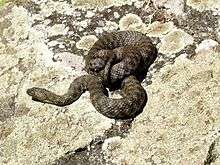Natricinae
The Natricinae are a subfamily of snakes in the family Colubridae. The subfamily comprises 37 genera. Members include many very common snake species, such as the European grass snakes, and the North American water snakes and garter snakes. Some Old World members of the subfamily are known as keelbacks, because their dorsal scales exhibit strong keeling.
| Natricinae | |
|---|---|
 | |
| Dice snake, Natrix tessellata | |
| Scientific classification | |
| Kingdom: | Animalia |
| Phylum: | Chordata |
| Class: | Reptilia |
| Order: | Squamata |
| Suborder: | Serpentes |
| Family: | Colubridae |
| Subfamily: | Natricinae Bonaparte, 1838 |
| Genera | |
|
37, see text | |
Natricine snakes are found in Africa, Asia, Europe, North America, and Central America as far south as Costa Rica. A single species, Tropidonophis mairii, reaches Australia. Although the highest diversity is in North America, the oldest members are in Asia and Africa, suggesting an Old World origin for the group. Most species are semiaquatic and feed on fish and amphibians, although a few are semifossorial or leaf-litter snakes that feed on invertebrates. Most species are harmless to humans, but a few (e.g., Thamnophis sirtalis, Thamnophis elegans) are capable of inflicting bites that can result in local, nonlife-threatening symptoms, and at least two members of the genus Rhabdophis (R. tigrinus and R. subminiatus) are capable of inflicting life-threatening bites to humans, though they have only enlarged, ungrooved fangs in the back of the mouth.[1]
Classification
While often regarded as a subfamily of the Colubridae,[2][3] in some classifications, they are raised to the family level as Natricidae.[4]
They are recognised as a sister group of the Dipsadinae plus the Pseudoxenodontinae.[2]
Genera
- Adelophis Dugès, 1879
- Afronatrix Rossman & Eberle, 1977
- Amphiesma A.M.C. Duméril, Bibron & A.H.A. Duméril, 1854
- Amphiesmoides Malnate, 1961
- Anoplohydrus F. Werner, 1909
- Aspidura Wagler, 1830
- Atretium Cope, 1861
- Clonophis Cope, 1889
- Fowlea Theobald, 1868
- Haldea Baird & Girard, 1853
- Hebius Thompson, 1913
- Helophis de Witte & Laurent, 1942
- Herpetoreas Günther, 1860
- Hydrablabes Boulenger, 1891
- Hydraethiops Günther, 1872
- Iguanognathus Boulenger, 1898
- Isanophis David, Pauwels, Nguyen & G. Vogel, 2015
- Limnophis Günther, 1865
- Liodytes Cope, 1885
- Natriciteres Loveridge, 1953
- Natrix Laurenti, 1768
- Nerodia Baird & Girard, 1853
- Opisthotropis Günther, 1872
- Paratapinophis Angel, 1929
- Pseudagkistrodon Van Denburgh, 1909
- Regina Baird & Girard, 1853
- Rhabdophis Fitzinger, 1843
- Rhabdops Boulenger, 1893
- Smithophis Giri, Gower, Das, Lalremsanga, Lalronunga, Captain & Deepak, 2019
- Storeria Baird & Girard, 1853
- Thamnophis Fitzinger, 1843
- Trachischium Günther, 1858
- Trimerodytes Cope, 1895
- Tropidoclonion Cope, 1860
- Tropidonophis Jan, 1863
- Virginia Baird & Girard, 1853
- Xenochrophis Günther, 1864
References
- Weinstein, Scott A.; Warrell, David A.; White, Julian; Keyler, Daniel E. (2011). Venomous Bites from Non-Venomous Snakes: A Critical Analysis of Risk and Management of "Colubrid" Snake Bites. London: Elsevier. 364 pp. ISBN 978-0123877321.
- Pyron, R. Alexander; et al. (2011). "The phylogeny of advanced snakes (Colubroidea), with discovery of a new subfamily and comparison of support methods for likelihood trees" (PDF). Molecular Phylogenetics and Evolution. 58 (2): 329–342. doi:10.1016/j.ympev.2010.11.006. PMID 21074626. Archived from the original (PDF) on 3 October 2013.
- "Natricinae". The Reptile Database, Zoological Museum Hamburg.
- Dowling, Herndon G.; Jenner, Janann V. (1988). Snakes of Burma: Checklist of reported species and bibliography. Smithsonian Herpetological Information Service #76. Washington, D.C.: Division of Amphibians and Reptiles, National Museum of Natural History, Smithsonian Institution. OCLC 23345387.
Further reading
- Goin, Coleman J.; Goin, Olive B.; Zug, George R. (1978). Introduction to Herpetology, Third Edition. San Francisco: W.H. Freeman and Company. xi + 378 pp. ISBN 0-7167-0020-4. (Natricinae, p. 326).